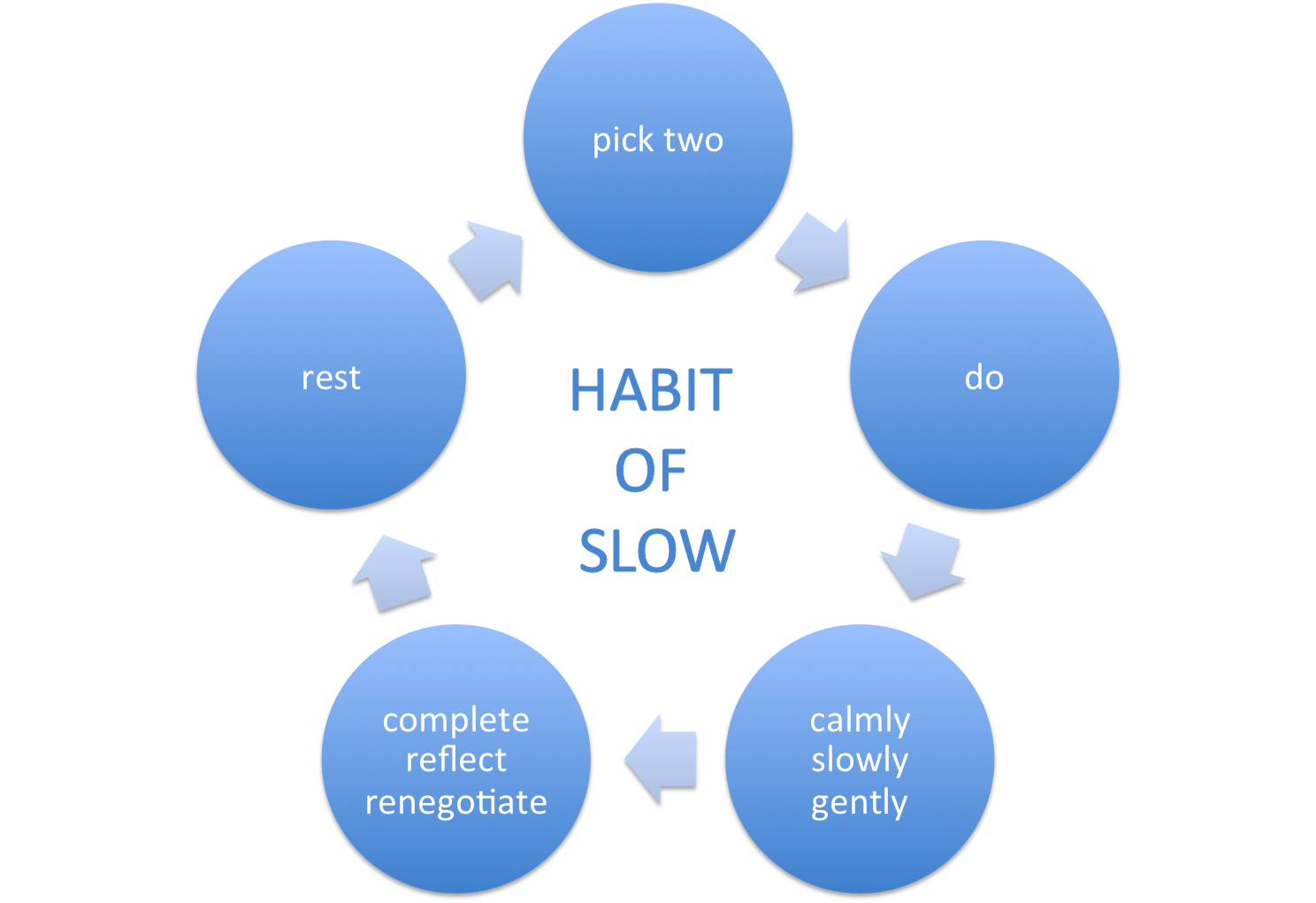The Habit of Slow

How many times have you heard the word slow associated with something positive?
We’re obsessed with speed—quick, instant, fast, rapid. We’re hooked on efficiency—do more in less time, scan, run, or at least power walk. It seems life is on fast forward most of the time.
Speed can be intoxicating and thrilling, in small doses. But after a while it becomes stressful. I don’t think we can give anything the focus and depth it deserves when we’re zooming in and out of our minutes and days—barely catching our breath … afraid we’re not doing enough.
Look at nature. The animals speed up when they need to (either to catch their prey or to run from a predator), then they slow down and take it easy. The earth, the waves, the wind, and the skies function in the same fashion—slow and easy most of the time, fast and uncompromising when there is a need for rebalancing.
There is calmness, beauty, and elegance in slow deliberate action and living.
I’ve been trying to slow down for a while and it’s not that easy. Even as I type these words, my hands are racing on the keyboard more than I’d like them to. I seem to dip in and out of awareness when it comes to how fast I’m going.
I’d like to slow down on purpose with intention and focus—without an ailment or an interruption forcing me to do so.
When we slow down, we can enjoy what we’re doing, give it the depth it deserves and ease into life.
And summer is the perfect time to take things easy and slow down. Why not work and live as gently as a breeze on a cool summer day?
How can we intentionally slow down?
If you are on board and want to slow down, consider these steps.
1- Consciously choose to do less
This takes trust and guts. You are choosing to cut down and this means you’re willing to miss out on stuff. Go deeper into a couple of things instead of barely scratching the surface of 10 things.
If you have numerous projects or tasks you’d like to do, just pick the most important two and let the rest either go, or put them on a someday list.
Instead of fearing that we’re missing out, we can focus on the joy of doing something well and having room to catch our breath.
2- Give each action the attention it deserves
Doing the best you can is the best way not only to get things done, but also to enjoy the doing. There is something magical about a job well done.
3- Let go of the concept of time
One certain way to drain your energy and force yourself to speed things up is to worry about time—it’s too late … I wish I’d done this sooner … I’m too old.
In the larger scheme of things nothing is really that important. Everything starts and ends and life goes on.
We can focus on doing something to the best of our ability without time being a factor. A state of flow is simply an immersion in the experience without much thought to a timeframe or outcome.
4- Define your outcome and/or enjoy the ride
If you’re working on a specific project, know what you want to achieve ahead of time. This means that you know when to stop.
For example, if I’m writing an article, I’ll have a basic outline of the main points to be covered as a starting point. During the writing process, new ideas will come up and others will be taken out. As I keep going, things start to take shape. The trick though is to know when to stop and be okay with it.
Your best will not be perfect (or at least not perfect to everyone). You get to define your best and that’s an art.
If you really want to get lost in something, do it without a specific outcome in mind and let life surprise you. In this case do the best you can till it’s not fun anymore. This is your signal that it’s time to move on.
5- Rest
If you’re tired you’re going to want to get things over and done with.
It’s a skill that we all can use—listening to our bodies and taking time off. If things take longer to complete, we need to stop and take a break, instead of pushing through and doing something half-assed.
Also we need to intend on taking time off after completing a major project.
After I finish a big task, I tell myself I’m going to do this and that. Before I finish, I’m already jumping ahead to what I’m going to do next. What happens usually is this: I crash and do nothing. Then I feel bad about it.
We need to take time off away from obligations and to-do lists. We should be able to say I’m just going to take the day off and do absolutely nothing—no work, no social visits, no house chores, no commitments whatsoever. Are you comfortable with that?
Taking things slowly requires consistent practice so we don’t go back to our speedy ways. We need to make slow a habit.
How to turn slow into a habit
Do steps 1-5 and keep doing them. Habits form through repetition. In order to keep slowing down, remind yourself of the need to do so. Consider these pointers.
Limiting commitments to yourself and others
Two non-negotiable main tasks per day are more than enough. Saying no is saying yes to less work and more freedom.
Deliberate slow focused action
Engage your senses in whatever you’re doing. What are you looking at? How does it feel?
Do for the joy and privilege of doing and being alive each moment.
Renegotiate your priorities each day
At the end of each day, take time to reflect on what you did and how you enjoyed it. You can also set your intentions for tomorrow’s main two tasks and let go of anything else.
Remember that you can always do more, after you complete your two tasks.
If you have to deal with unexpected interruptions, you can shift to the disruption (if it’s important to you) and then refocus back on your main two.
The mantra of slow: Calmly … slowly … gently
As you start anything, think of these words: calmly … slowly … gently (or create your own mantra that resonates with you). Let the words guide you.
Extend the practice to everything you do—eating, bathing, driving, moving, and being. Turn slow into a way of life, one action at a time … calmly … slowly … gently.
Here is a simple diagram as a reminder.
